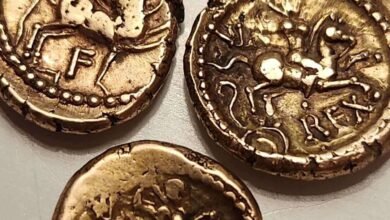Archaeologists discover ancient Chinese tombs filled with treasures

- Archaeologists have discovered three 1,800-year-old tombs from ancient China.
- The design of the graves resembles that of a house and highlights the importance of the family, even during the funeral.
- While looters almost emptied two of the three graves, one remained largely untouched and contained a family treasure.
Archaeologists discovered three remarkable 1,800-year-old residential-style tombs with rooms and windows where an ancient Chinese family was buried along with their valuable possessions.
Archaeologists stumbled upon the tombs, which date back to the Han Dynasty, while preparing to expand a local park in Rizhao, China. But the archaeologists were not the first to find the tombs; looters had previously discovered at least parts of them, largely emptying two of the tombs while leaving the third relatively untouched.
According to a translated statement from the Institute of Archaeology of the Chinese Academy of Social Sciences, which was published by the Miami-HeraldWhat makes the tombs so fascinating – apart from the 70 artifacts that represent a family treasure and are located in the third tomb – is the domestic design.
Two of the tombs contained inscriptions with the surname Huan, showing the clear family connection between them. Experts say the tombs, which are accessed via passageways, share a similar design. The best-preserved tomb, known as M3, includes interconnected rooms with wooden windows and doors, suggesting it may have been the final resting place of a married couple.
During the excavation in Rizhao, about 640 kilometers from Beijing, more than 70 artifacts were found, ranging from an iron sword to bronze mirrors and various pottery items. These were probably the family’s treasure, say the archaeologists.
In a particularly unusual discovery, the team also discovered parts of a coffin cart used to transport the coffins into the tomb, which the archaeologists described as “exquisitely crafted and an unusual find.”
The discovery of ancient tombs in China sheds light on cultural practices of past eras. A more recent find from the Second Jin Dynasty, dating back about 800 years, provides evidence of non-Chinese influences in the cultural fabric of Shanxi Province.
This discovery, which also involved three tombs, showed that each tomb had its own distinctive character and style, from the architectural design to the wall paintings. Arches, doors and windows carved into brick played an important role, and the wall paintings depicted plant patterns and figures. Each tomb told its own story with epitaphs and inscriptions that linked together historical and geographical information that was significant at the time.
Tim Newcomb is a journalist based in the Pacific Northwest. He covers stadiums, sneakers, equipment, infrastructure and more for various publications, including Popular Mechanics. His favorite interviews include speaking with Roger Federer in Switzerland, Kobe Bryant in Los Angeles and Tinker Hatfield in Portland.



